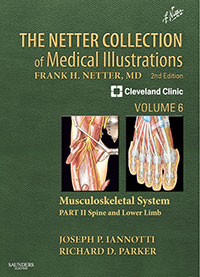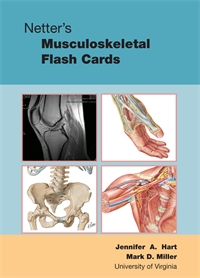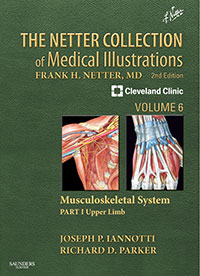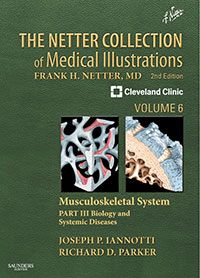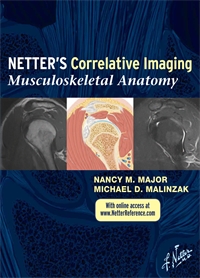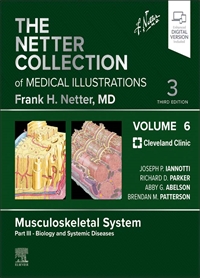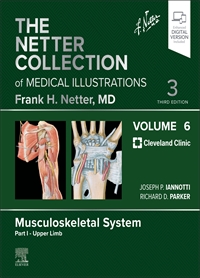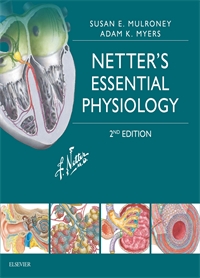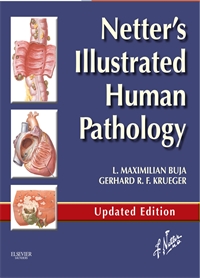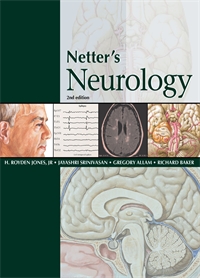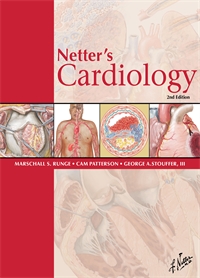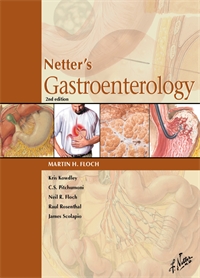Collection of Medical Illustrations, Musculoskeletal System - Volume 6, Part II - 2E
Author: Joseph P. Iannotti, Richard D. Parker
ISBN: 9781416063827
- Page 2: Vertebral Column
- Page 3: Atlas and Axis -- Anatomy of Craniocervical Junction
- Page 4: External Craniocervical Ligaments
- Page 5: Internal Craniocervical Ligaments
- Page 6: Suboccipital Triangle
- Page 7: Dens Fracture
- Page 8: Jefferson and HangmanԳ Fractures
- Page 9: Cervical Vertebrae
- Page 10: Muscles of Back: Superficial Layers
- Page 11: Muscles of Back: Intermediate and Deep Layers
- Page 12: Spinal Nerves and Sensory Dermatomes
- Page 13: Cervical Spondylosis
- Page 14: Cervical Spondylosis and Myelopathy
- Page 15: Cervical Disc Herniation: Clinical Manifestations
- Page 16: Surgical Approaches for the Treatment of Myelopathy and Radiculopathy
- Page 17: Extravascular Compression of Vertebral Arteries
- Page 18: Thoracic Vertebrae and Ligaments
- Page 19: Lumbar Vertebrae and Intervertebral Discs
- Page 20: Sacral Spine and Pelvis
- Page 21: Lumbosacral Ligaments
- Page 22: Degenerative Disc Disease
- Page 23: Lumbar Disc Herniation
- Page 24: Lumbar Spinal Stenosis
- Page 25: Lumbar Spinal Stenosis (Continued)
- Page 26: Degenerative Lumbar Spondylolisthesis
- Page 27: Degenerative Spondylolisthesis: Cascading Spine
- Page 28: Adult Deformity
- Page 29: Three-Column Concept of Spinal Stability and Compression Fractures
- Page 30: Compression Fractures (Continued)
- Page 31: Burst, Chance, and Unstable Fractures
- Page 32: Congenital Anomalies of Occipitocervical Junction
- Page 33: Congenital Anomalies of Occipitocervical Junction (Continued)
- Page 34: Synostosis of Cervical Spine (Klippel-Feil Syndrome)
- Page 35: Clinical Appearance of Congenital Muscular Torticollis (Wryneck)
- Page 36: Clinical Appearance of Congenital Muscular Torticollis (Wryneck)
- Page 37: Pathologic Anatomy of Scoliosis
- Page 38: Typical Scoliosis Curve Patterns
- Page 39: Congenital Scoliosis: Closed Vertebral Types (MacEwen Classification)
- Page 40: Clinical Evaluation of Scoliosis
- Page 41: Determination of Skeletal Maturation, Measurement of Curvature, and Measurement of Rotation
- Page 42: Braces for Scoliosis
- Page 43: Scheuermann Disease
- Page 44: Congenital Kyphosis
- Page 45: Spondylolysis and Spondylolisthesis
- Page 46: Myelodysplasia
- Page 47: Lumbosacral Agenesis
- Page 0: "Arteries and Nerves of Thigh: Anterior Views
- Page 0: "Arteries and Nerves of Thigh: Deep Dissection (Anterior View)
- Page 50: Superficial Veins and Cutaneous Nerves
- Page 52: Lumbosacral Plexus
- Page 53: Sacral and Coccygeal Plexuses
- Page 54: Nerves of Buttock
- Page 55: Femoral Nerve (L2, 3, 4) and Lateral Femoral Cutaneous Nerve (L2, 3)
- Page 56: Obturator Nerve (L2, 3, 4)
- Page 57: Sciatic Nerve (L4, 5; S1, 2, 3) and Posterior Femoral Cutaneous Nerve (S1, 2, 3)
- Page 58: Muscles of Front of Hip and Thigh
- Page 59: Muscles of Hip and Thigh (Anterior and Lateral Views)
- Page 60: Muscles of Back of Hip and Thigh
- Page 61: Bony Attachments of Muscles of Hip and Thigh: Anterior View
- Page 62: Bony Attachments of Muscles of Hip and Thigh: Posterior View
- Page 63: Cross-Sectional Anatomy of Hip: Axial View
- Page 64: Cross-Sectional Anatomy of Hip: Coronal View
- Page 65: Cross-Sectional Anatomy of Thigh
- Page 68: Arteries and Nerves of Thigh: Deep Dissection (Posterior view)
- Page 69: Bones and Ligaments at Hip: Osteology of the Femur
- Page 70: Bones and Ligaments at Hip: Hip Joint
- Page 72: Proximal Femoral Focal Deficiency: Radiographic Classification
- Page 73: Proximal Femoral Focal Deficiency: Clinical Presentation
- Page 74: Congenital Short Femur with Coxa Vara
- Page 75: Recognition of Developmental Dislocation of the Hip
- Page 76: Clinical Findings in Developmental Dislocation of Hip
- Page 77: Radiologic Diagnosis of Developmental Dislocation of Hip
- Page 78: Adaptive Changes in Dislocated Hip That Interfere with Reduction
- Page 79: Device for Treatment of Clinically Reducible Dislocation of Hip
- Page 80: Blood Supply to Femoral Head in Infancy
- Page 81: Legg-Clav-Perthes Disease: Pathogenesis
- Page 82: Legg-Clav-Perthes Disease: Physical Examination
- Page 83: Legg-Clav-Perthes Disease: Physical Examination (Continued)
- Page 84: Stages of Legg-Calv-Perthes Disease
- Page 85: Legg-Calv-Perthes Disease: Lateral Pillar Classification
- Page 86: Legg-Calv-Perthes Disease: Conservative Management
- Page 87: Femoral Varus Derotational Osteotomy
- Page 88: Innominate Osteotomy
- Page 89: Innominate Osteotomy (Continued)
- Page 90: Physical Examination and Classification of Slipped Capital Femoral Epiphysis
- Page 91: Pin Fixation in Slipped Capital Femoral Epiphysis
- Page 92: Hip Joint Involvement in Osteoarthritis
- Page 93: Total Hip Replacement: Prostheses
- Page 94: Total Hip Replacement: Steps 1 to 3
- Page 95: Total Hip Replacement: Steps 4 to 8
- Page 96: Total Hip Replacement: Steps 9 to 12
- Page 97: Total Hip Replacement: Steps 13 to 18
- Page 98: Total Hip Replacement: Steps 19 and 20
- Page 99: Total Hip Replacement: Dysplastic Acetabulum
- Page 100: Total Hip Replacement: Protrusio Acetabuli
- Page 101: Total Hip Replacement: ComplicationsЌoosening of Femoral Component
- Page 102: Total Hip Replacement: ComplicationsІractures of Femur and Femoral Component
- Page 103: Total Hip Replacement: ComplicationsЌoosening of Acetabular Component and Dislocation of Total Hip Prosthesis
- Page 104: Total Hip Replacement: Infection
- Page 105: Total Hip Replacement: Hemiarthroplasty of Hip
- Page 106: Hip Resurfacing
- Page 107: Rehabilitation After Total Hip Replacement
- Page 108: Femoroacetabular Impingement/Hip Labral Tears
- Page 109: Avascular Necrosis
- Page 110: Trochanteric Bursitis
- Page 111: Snapping Hip (Coxa Saltans)
- Page 112: Muscle Strains
- Page 113: Injury to Pelvis: Stable Pelvic Ring Fractures
- Page 114: Injury to Pelvis: Straddle Fracture and Lateral Compression Injury
- Page 115: Injury to Pelvis: Open Book Fracture
- Page 116: Injury to Pelvis: Vertical Shear Fracture
- Page 117: Injury to Hip: Acetabular Fractures
- Page 118: Injury to Hip: Acetabular Fractures (Continued)
- Page 119: Injury to Hip: Posterior Dislocation of Hip
- Page 120: Injury to Hip: Anterior Dislocation of Hip, Obturator Type
- Page 121: Injury to Hip: Dislocation of Hip with Fracture of Femoral Head
- Page 122: Injury to Femur: Intracapsular Fracture of Femoral Neck
- Page 123: Injury to Femur: Intertrochanteric Fracture of Femur
- Page 124: Injury to Femur: Subtrochanteric Fracture of Femur
- Page 125: Injury to Femur: Fracture of Shaft of Femur
- Page 126: Injury to Femur: Fracture of Distal Femur
- Page 127: Amputation of Lower Limb and Hip (Disarticulation and Hemipelvectomy)
- Page 130: Topographic Anatomy of the Knee
- Page 131: Osteology of the Knee
- Page 132: Knee: Lateral and Medial Views
- Page 133: Knee: Anterior Views
- Page 134: Knee: Posterior and Sagittal Views
- Page 135: Knee: Interior View and Cruciate and Collateral Ligaments
- Page 136: Arteries and Nerves of Knee
- Page 137: Arthrocentesis of Knee Joint
- Page 138: Types of Meniscal Tears and Discoid Meniscus Variations
- Page 139: Tears of the Meniscus
- Page 140: Medial and Lateral Meniscus
- Page 141: Rupture of the Anterior Cruciate Ligament
- Page 142: Lateral Pivot Shift Test for Anterolateral Knee Instability
- Page 143: Rupture of Cruciate Ligaments: Arthroscopy
- Page 144: Rupture of Posterior Cruciate Ligament
- Page 145: Physical Examination of the Leg and Knee
- Page 146: Sprains of Knee Ligaments
- Page 147: Disruption of Quadriceps Femoris Tendon or Patellar Ligament
- Page 148: Dislocation of Knee Joint
- Page 149: Progression of Osteochondritis Dissecans
- Page 150: Osteonecrosis
- Page 151: Tibial Intercondylar Eminence Fracture
- Page 152: Synovial Plica
- Page 153: Synovial Plica (Arthroscopy), Bursitis, and Iliotibial Band Friction Syndrome
- Page 154: Pigmented Villonodular Synovitis and Meniscal Cysts
- Page 155: Rehabilitation After Injury to Knee Ligaments
- Page 156: Bipartite Patella and BakerԳ Cyst
- Page 157: Subluxation and Dislocation of Patella
- Page 158: Fracture of the Patella
- Page 159: Osgood-Schlatter Lesion
- Page 160: Knee Arthroplasty: Osteoarthritis of the Knee
- Page 161: Knee Arthroplasty: Total Condylar Prosthesis and Unicompartmental Prosthesis
- Page 162: Knee Arthroplasty: Posterior Stabilized Knee Prosthesis
- Page 163: Total Knee Replacement Technique: Steps 1 to 5
- Page 164: Total Knee Replacement Technique: Steps 6 to 9
- Page 165: Total Knee Replacement Technique: Steps 10 to 14
- Page 166: Total Knee Replacement Technique: Steps 15 to 20
- Page 167: Medial Release for Varus Deformity of Knee
- Page 168: Lateral Release for Valgus Deformity of Knee
- Page 169: Rehabilitation After Total Knee Replacement
- Page 170: High Tibial Osteotomy for Varus Deformity of Knee
- Page 171: Below Knee Amputation
- Page 172: Disarticulation of Knee and Above-Knee Amputation
- Page 174: Topographic Anatomy of the Lower Leg
- Page 175: Fascial Compartments of Leg
- Page 176: Muscles of Leg: Superificial Dissection (Anterior View)
- Page 177: Muscles of Leg: Superficial Dissection (Lateral View)
- Page 178: Muscles, Arteries, and Nerves of Leg: Deep Dissection (Anterior view)
- Page 179: Muscles of Leg: Superficial Dissection (Posterior View)
- Page 180: Muscles of Leg: Intermediate Dissection (Posterior View)
- Page 181: Muscles, Arteries, and Nerves of Leg: Deep Dissection (Posterior view)
- Page 182: Common Peroneal Nerve
- Page 183: Tibial Nerve
- Page 184: Tibia and Fibula
- Page 185: Tibia and Fibula (Continued)
- Page 186: Bony Attachments of Muscles of Leg
- Page 187: Fracture of Proximal Tibia Involving Articular Surface
- Page 188: Fracture of Shaft of Tibia
- Page 189: Fracture of Tibia in Children
- Page 190: Bowleg and Knock-Knee
- Page 191: Blount Disease
- Page 193: Toeing In: Internal Femoral Torsion
- Page 194: Toeing Out and Postural Torsional Effects on Lower Limbs
- Page 196: Surface Anatomy and Muscle Origins and Insertions
- Page 197: Tendon Sheaths of Ankle
- Page 198: Ligaments and Tendons of Ankle
- Page 199: Dorsal Foot: Superficial Dissection
- Page 200: Dorsal Foot: Deep Dissection
- Page 201: Plantar Foot: Superficial Dissection
- Page 202: Plantar Foot: First Layer
- Page 203: Plantar Foot: Second Layer
- Page 204: Plantar Foot: Third Layer
- Page 205: Interosseous Muscles and Deep Arteries of Foot
- Page 206: Cross-Sectional Anatomy of Ankle and Foot
- Page 207: Cross-Sectional Anatomy of Ankle and Foot (Continued)
- Page 208: Bones of Foot
- Page 209: Bones of Foot (Continued)
- Page 210: Ligaments and Tendons of Foot: Plantar View
- Page 211: Lymph Vessels and Nodes of Lower Limb
- Page 212: Major Sprains and Sprain Fractures
- Page 213: Mechanisms of Ankle Sprains
- Page 214: Rotational Fractures
- Page 215: Repair of Fracture of Malleolus
- Page 216: Pilon Fracture
- Page 217: Talus Fracture
- Page 218: Extraarticular Fracture of Calcaneus
- Page 219: Intra-articular Fracture of Calcaneus
- Page 220: Fifth Metatarsal Fractures
- Page 221: Lisfranc Injury
- Page 222: Navicular Stress Fractures
- Page 223: Achilles Tendon Rupture
- Page 224: Peroneal Tendon Injury
- Page 225: Osteochondral Lesions of the Talus
- Page 226: Turf Toe
- Page 227: Plantar Fasciitis
- Page 228: Posterior Tibial Tendonitis/Flatfoot
- Page 229: Congenital Clubfoot
- Page 230: Congenital Clubfoot (Continued)
- Page 231: Congenital Vertical Talus
- Page 232: Cavovarus Foot
- Page 233: Calcaneovalgus and Planovalgus
- Page 234: Tarsal Coalition
- Page 235: Tarsal Coalition (Continued)
- Page 236: Accessory Tarsal Navicular
- Page 237: Congenital Toe Deformities
- Page 238: Khler Disease
- Page 239: Common Foot Infections
- Page 240: Deep Infections of Foot
- Page 241: Lesions of the Diabetic Foot
- Page 242: Clinical Evaluation of Patient with Diabetic Foot Lesion
- Page 243: Amputation of Foot
- Page 244: Syme Amputation (Wagner Modification)
